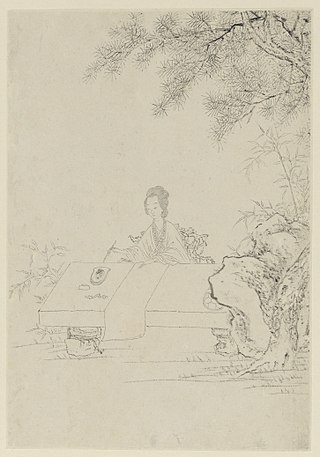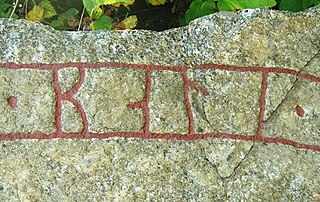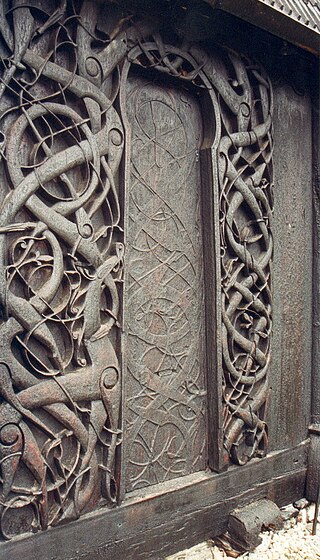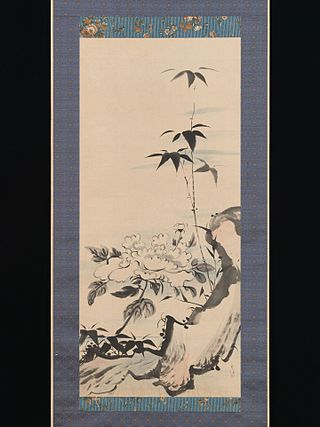
Wei Shuo, courtesy name Mouyi (茂猗), sobriquet He'nan (和南), commonly addressed just as Lady Wei (衛夫人), who lived during the Eastern Jin, was one of the most famous of all Chinese calligraphers in history. She was a pioneer, who established new rules that developed the regular script. As a teacher, her most notable disciple was Wang Xizhi.
Ergi (noun) and argr (adjective) are two Old Norse terms of insult, denoting effeminacy or other unmanly behaviour. Argr is "unmanly" and ergi is "unmanliness"; the terms have cognates in other Germanic languages such as earh, earg, arag, or arug, among others.

The Hillersjö stone, listed in the Rundata catalog as U 29 and located at Hillersjö, which is about four kilometers north of Stenhamra on Färingsö, is a runic Younger Futhark inscription that tells, in Old Norse, the tragic real life family saga of Gerlög and her daughter Inga. It is the longest runic inscription in Uppland and the second longest one in Sweden after the Rök runestone.

Ende is the first Spanish female manuscript illuminator to have her work documented through inscription: ENDE PINTRIX ET D(E)I AIUTRIX in the colophon of the Gerona Beatus. Most information about her comes down to the inscription in her artwork as there was no other record. Her lifetime is not known but can be assumed based on the inscription era in the Gerona Beatus: AD 975. The appellation of “dei aiutrix” alludes to the fact that she was probably a nun however it has been found what her foundation was. There are a number of hands discernible in the manuscripts. The chief scribe was a priest called Senior. Historians have also attributed elements of the manuscripts to Emetrius, whose style is attributable in comparison to an earlier signed work. However, based on painting style attributes, some theorists conclude that nearly all of the manuscript illustrations were completed by Ende.
Agnes Helen Nicholls CBE was one of the greatest English sopranos of the 20th century, both in the concert hall and on the operatic stage.

The Odendisa Runestone, sometimes called the Hassmyra Runestone, is a Viking Age runestone erected at Hassmyra, Västmanland, Sweden. It is exceptional in that it has a metric inscription, and in commemorating a woman.

Öpir or Öper was a runemaster who flourished during the late 11th century and early 12th century in Uppland, Sweden. He was the most productive of all the old runemasters and his art is classified as being in the highly refined Urnes style.

A runemaster or runecarver is a specialist in making runestones.

Balle or Red-Balle was a runemaster who was active in the areas of western Uppland, Västmanland, and northern Södermanland of Sweden during the second half of the 11th century.

Fot was a runemaster who flourished in mid-11th century Sweden.

The style or design of runestones varied during the Viking Age. The early runestones were simple in design, but towards the end of the runestone era they became increasingly complex and made by travelling runemasters such as Öpir and Visäte.

Frögärd Ulvsdotter i Ösby was a Swedish Norse woman. She was according to a common misconception believed to be a Viking Age female runemaster. This notion is based on Erik Brate's erroneous interpretation of runestone U 203. As early as 1943, Elias Wessén convincingly demonstrated that the sequence in question cannot be read as a carver's signature. Also, the place name uisby should be read Väsby rather than Ösby.

The Holmfast Inscriptions are two Viking Age memorial runic inscriptions and one image that are designated as Sö 311, Sö 312, and Sö 313 in the Rundata catalog. They are located in Södertälje, Stockholm County and the province of Södermanland, Sweden by the eponymous road Holmfastvägen.

The Björklinge runestones are five Viking Age memorial runestones designated in the Rundata catalog as U 1045, U 1046, U 1047, U 1048, and U 1050 that are located at the church in Björklinge, Uppsala County, Sweden, which is in the historic province of Uppland. In addition, there is a small fragment of a runestone with a partial runic text i * lit * rita * meaning "had erected" that has been given the catalog number U 1049.

Södermanland Runic Inscription 178 or Sö 178 is the Rundata catalog number for a Viking Age memorial runestone which is located at Gripsholm Castle, Södermanland County, Sweden, which is in the historic province of Södermanland.

Västergötland Runic Inscription 90 or Vg 90 is the Rundata listing for a Viking Age memorial runestone located in Torestorp, which is about three kilometers northwest of Gudhem, Västra Götaland County, Sweden, and in the historic province of Västergötland.
Nazaria Lagos was a nurse in the Revolution in the Philippine–American War. She was known as the Florence Nightingale of Panay, as she provided medical treatment to combatants and civilians.
The West Computers were the African American, female mathematicians who worked as human computers at the Langley Research Center of NACA from 1943 through 1958. These women were a subset of the hundreds of female mathematicians who began careers in aeronautical research during World War II. To offset the loss of manpower as men joined the war effort, many U.S. organizations began hiring, and actively recruiting, more women and minorities during the 1940s. In 1935, the Langley Research Center had five female human computers on staff. By 1946, the Langley Research Center had recruited about 400 female human computers.

Ike Gyokuran was a Japanese Bunjinga painter, calligrapher, and poet. She was famous in Kyoto, Japan, during her lifetime, and she remains a celebrated artist in Japan.
Zing Tsjeng is a Singaporean journalist, non-fiction author, and podcaster based in London. As of 2023, she is the editor in chief of Vice UK and Vice.com. She launched Broadly for the network in 2014.















